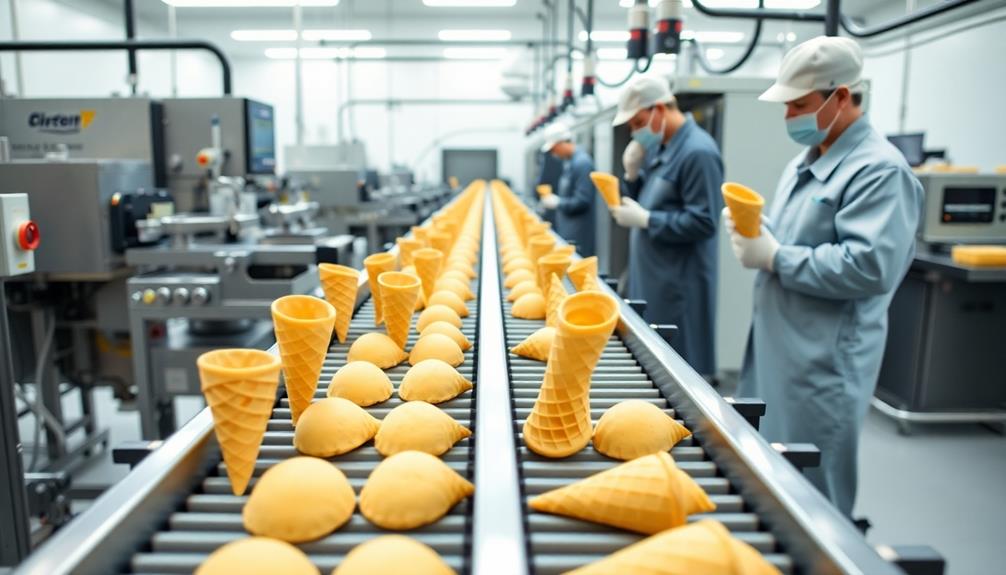The history of the ice cream cone is a delightful mix of innovation and culture. You might find it surprising that the first visual of an ice cream cone dates back to 1807. However, it truly gained fame at the 1904 St. Louis World's Fair, thanks to Ernest A. Hamwi, who shaped waffles into cones. With the invention of cone-making machines, mass production took off, leading to an explosion in popularity. By the 1920s, the cone had evolved into a staple in ice cream parlors across America. Curious about how it shaped modern desserts? There's much more to discover!
Key Takeaways
- The ice cream cone gained popularity at the 1904 St. Louis World's Fair, where vendors served ice cream in rolled waffle cones.
- Italo Marchiony patented a machine for making edible cones in 1903, laying the groundwork for mass production.
- Ernest A. Hamwi is often credited with popularizing the ice cream cone during the 1904 fair.
- Ice cream cones evolved into rolled and molded types, with automated production increasing efficiency and consistency.
- The cone's cultural significance has made it an enduring symbol of summer, linked to nostalgia and childhood memories.
Origins of the Ice Cream Cone

The history of the ice cream cone traces back to intriguing beginnings, with the earliest visual evidence appearing in a 1807 etching by Philibert-Louis Debucourt. This suggests that the concept of edible cones existed long before they became popular in the early 1900s.
In 1887, Agnes B. Marshall's cookbook included a recipe for "Cornets with Cream," highlighting that people were experimenting with edible vessels for ice cream even earlier.
In 1903, Italo Marchiony, an Italian immigrant, patented a machine that made edible ice cream cups. This invention paved the way for the ice cream cone's development. While Marchiony played a significant role, it's crucial to recognize that other individuals, like Ernest Hamwi, also claimed to be inventors of the ice cream cone. The true origin remains unclear, with various contributors shaping its history.
The pivotal moment for ice cream cones came during the 1904 St. Louis World's Fair, where vendors served ice cream in rolled waffle cones after running out of traditional serving dishes.
This event marked a turning point, leading to the widespread popularity of ice cream cones as a beloved treat.
The 1904 World's Fair

At the 1904 World's Fair, the ice cream cone skyrocketed in popularity, thanks to its unique serving style.
You'll find that Ernest A. Hamwi played an essential role by creatively transforming his waffles into cone shapes when a neighboring vendor ran out of dishes.
This innovative moment not only changed how ice cream was enjoyed but also marked the beginning of the cone's status as a beloved American treat.
Ice Cream Cone Popularization
In 1904, the St. Louis World's Fair transformed the ice cream cone into a beloved American treat. As fairgoers flocked to the event, they indulged in vast quantities of ice cream served in this innovative cone format. The fair's atmosphere and high daily attendance—over 35,000 people—helped cement the ice cream cone's place in American dessert culture.
Ernest A. Hamwi, a waffle vendor, played an essential role in this popularization. He ingeniously rolled his waffles into cone shapes when an ice cream vendor ran out of dishes. This convenient serving method quickly caught on, leading to:
- Increased visibility of ice cream cones at the fair
- A surge in ice cream vendors showcasing their products
- Widespread acceptance of cones as a classic treat
- A wave of claims regarding the invention of the cone
- The shift of the ice cream cone from novelty to staple
The 1904 St. Louis World's Fair marked a pivotal moment, pushing the ice cream cone into mainstream popularity and solidifying its status in American dessert culture.
Key Figures Involved
While many contributed to the ice cream cone's rise during the 1904 World's Fair, a few key figures stand out for their significant roles.
Ernest A. Hamwi, a waffle vendor at the fair, is often credited with popularizing the ice cream cone. When an ice cream vendor ran out of dishes, Hamwi creatively shaped his waffles into cones, providing a perfect solution that delighted fairgoers.
Italo Marchiony also played a vital role. He'd patented a machine for making edible ice cream cups in 1903 and claimed to have invented the ice cream cone, with his daughter asserting it was created at the 1893 World's Fair.
Meanwhile, his cousin, Frank Marchiony, established the Valvona-Marchiony Company in 1902, launching multiple factories and competing in the ice cream cone market.
Another notable figure, Abe Doumar, began selling custom-made ice cream cones at Coney Island in 1905. His efforts further expanded the commercialization of the cone.
The surge in popularity at the St. Louis World's Fair, where daily attendance exceeded 35,000, firmly established the ice cream cone as a quintessential American treat.
Key Figures in Cone History

Several key figures played pivotal roles in the history of the ice cream cone, shaping its invention and popularity. First, Italo Marchiony, an Italian immigrant, patented the first ice cream cone-making machine in 1903. He claimed to have invented the cone prior to the 1904 St. Louis World's Fair.
Ernest A. Hamwi, a waffle vendor at that fair, popularized the cone by rolling his warm waffles into cone shapes when another vendor ran out of cups.
Other influential figures include:
- Abe Doumar, who established a successful ice cream cone stand on Coney Island in 1905, boosting the cone's popularity.
- Frank Marchiony, Italo's cousin, founded the Valvona-Marchiony Company in 1902, a leading manufacturer of ice cream cups.
- Antonio Valvona, who patented a machine for baking biscuit cups in 1902, greatly contributed to edible ice cream containers.
These innovators not only created the ice cream cones we enjoy today but also laid the groundwork for the cone's enduring legacy in dessert culture.
Their contributions helped transform the simple idea of serving ice cream into a beloved treat enjoyed worldwide.
Legal Battles and Patents

The ice cream cone's journey was fraught with legal challenges and patent disputes that shaped its development in the early 20th century. The Valvona-Marchiony Company, led by Antonio Valvona, became the dominant ice cream cone manufacturer after securing a patent in 1902 for baking biscuit cups.
However, by 1910, legal battles erupted as rival manufacturers began contesting this patent. The courts issued varying rulings, creating uncertainty for ice cream cone producers.
A pivotal moment occurred in 1914 when the Federal Court of Appeals ruled that Valvona's patent was ineffective. This decision complicated the landscape for ice cream cone manufacturers, as it opened the floodgates for competition and innovation.
Disputes over the classification of ice cream cornucopias added another layer of complexity, highlighting the intricacies of patent infringement claims.
The competitive environment following the 1904 World's Fair intensified the situation, leading to multiple claims of invention. As you can see, the legal battles surrounding the ice cream cone not only impacted the industry's growth but also influenced how different manufacturers approached their products and patents in this burgeoning market.
Evolution of Cone Types

Ice cream cones underwent significant evolution in their design and production methods, leading to the two main types we enjoy today: rolled cones and molded cones. Rolled cones are crafted from waffle batter that's baked and then shaped into a cone, while molded cones are produced by pouring batter into specific molds. This shift from hand-rolled cones to mechanical production marked a major turning point in cone manufacturing.
Key innovations in production techniques during the early 20th century included:
- The introduction of automatic machinery, producing up to 150,000 cones every 24 hours
- Enhanced consistency and quality in cone production
- Specialized baking equipment developed in St. Louis, a hub for ice cream cone manufacturing
- The ability to meet the soaring demand, with 245 million cones produced in the U.S. by 1924
- Increased collaboration among ice cream manufacturers to refine cone recipes
These advancements in baking and production methods not only revolutionized how cones are made but also solidified their place in the ice cream industry, creating a delightful treat that continues to be enjoyed today.
Growth of the Ice Cream Industry

As ice cream cones gained popularity, especially after their debut at the 1904 St. Louis World's Fair, the growth of the ice cream industry took off. You could see how ice cream cones come to dominate the dessert scene, with consumers enthusiastic for this convenient way to enjoy their favorite treat.
By 1924, a staggering 245 million cones were produced, showcasing their widespread acceptance in American culture.
Innovations in automatic machinery revolutionized production, allowing manufacturers to churn out around 150,000 cones every 24 hours. This efficiency spurred the establishment of companies like the Cornucopia Waffle Company and the Missouri Cone Company, essential players in the burgeoning ice cream cone market.
These cone-shaped containers became staples in ice cream parlors across the United States, adapting to changing consumer preferences with various flavors and styles.
You can appreciate how the ice cream cone not only changed how you enjoy American ice but also paved the way for an entire industry. This growth marked a significant chapter in the history of desserts, making ice cream cones an iconic symbol of summer and joy for generations.
Myths and Cultural Significance

You might be surprised to learn that the ice cream cone's invention is shrouded in controversy, with several individuals claiming to be its creator.
As you explore its cultural significance, you'll see how it's not just a dessert but a nostalgic symbol of summer and childhood memories.
Understanding these myths and their impact helps reveal why the ice cream cone holds such a special place in American culture.
Inventor Controversies
The invention of the ice cream cone is shrouded in controversy, with multiple figures claiming credit for its creation. While many attribute the ice cream cone to Ernest A. Hamwi at the 1904 St. Louis World's Fair, other contenders like Italo Marchiony and Abe Doumar also emerge. The truth is more complex, as myths surrounding its origin often tie back to the cultural significance of that fair rather than clear evidence.
Here are some key points to examine:
- Agnes B. Marshall's 1887 recipe for "Cornets with Cream" suggests edible cones existed before the fair.
- The evolution of ice cream serving methods reflects changing culinary practices and hygiene standards.
- Inventor controversies highlight the blend of immigrant contributions and American entrepreneurial spirit.
- The ice cream cone has become a symbol of nostalgia, evoking childhood memories.
- Its journey to becoming a modern ice cream staple illustrates the impact of consumer trends and commercialization.
Ultimately, the debate over who truly invented the ice cream cone speaks to broader themes in food history, showcasing how myths can shape our understanding of beloved culinary traditions.
Cultural Impact Over Time
Throughout the decades, the ice cream cone has evolved from a fairground novelty into a beloved American icon, deeply embedded in the cultural fabric of summer. Linked to the 1904 St. Louis World's Fair, it captured the hearts and taste buds of fairgoers, paving the way for its rise in popularity. Myths about its invention abound, with figures like Ernest Hamwi and Italo Marchiony often mentioned, but no single origin story can claim definitive proof.
The ice cream cone's cultural significance is evident as it changed from a simple treat to a staple in ice cream parlors across the nation. This shift reflects changing consumer trends, emphasizing the desire for convenience in a portable format. As you savor your cone, you can't help but feel a wave of nostalgia, recalling childhood summers filled with laughter and melted ice cream dribbling down your hand.
Moreover, the ice cream cone's popularity has driven significant economic impact in the food sector, contributing to seasonal spikes in sales and job creation during warmer months. Its enduring presence guarantees that the ice cream cone will remain a cherished symbol of summer for generations to come.
Modern Manufacturing Techniques

Today's ice cream cone manufacturing relies on advanced techniques that assure efficiency and consistency. You might be surprised to learn that modern ice cream cones are produced using specialized molding machines that bake batter into cone shapes, guaranteeing uniformity in size and texture.
Since Frederick Bruckman perfected high-speed production in 1912, the industry has seen remarkable advancements, allowing machines to churn out around 150,000 cones every 24 hours.
Here are some key aspects of modern manufacturing techniques in the ice cream cone industry:
- Specialized Molding Machines: These machines create precise cone shapes, minimizing waste.
- High-Speed Production: Significant advancements have made mass production feasible.
- Quality Control Measures: Rigorous testing assures cones meet specific standards for texture and integrity.
- Material Variety: The industry now offers sugar, waffle, and cake cones to cater to diverse tastes.
- Sustainable Practices: Many manufacturers are adopting eco-friendly materials and processes.
With these innovations, the ice cream cone continues to evolve, meeting consumer preferences while maintaining quality and efficiency.
Frequently Asked Questions
What Was the Ice Cream Cone Originally Invented For?
You might be surprised to learn the ice cream cone was originally invented to provide a convenient, edible container for serving ice cream, replacing unsanitary methods that involved reusable glass dishes and promoting a cleaner dessert experience.
What Is a Fun Fact About the Ice Cream Cone?
Did you know that over 245 million ice cream cones were produced in 1924? This surge was thanks to new machinery, making it easier than ever to enjoy this delicious, portable treat on a hot summer day.
What Did They Use Before Ice Cream Cones?
Before ice cream cones, you'd enjoy your sweet treat in unsanitary penny licks or fancy glass cups, risking a delightful mix of germs and awkwardness. Ah, the joys of 19th-century ice cream indulgence!
Were Ice Cream Cones Invented to Hold Flowers?
No, ice cream cones weren't invented to hold flowers. They were designed to serve ice cream conveniently. While decorative uses might exist, their primary purpose has always been to provide a tasty, edible container for ice cream.
Conclusion
In wrapping up the delightful journey of the ice cream cone, you see how this sweet treat has evolved from a simple idea into a beloved staple. Just like the perfect scoop of ice cream, its history is layered with flavor, creativity, and innovation. As you enjoy your next cone, remember the countless hands that shaped its story and the joy it brings. The ice cream cone isn't just a dessert; it's a delicious slice of history you can savor!









